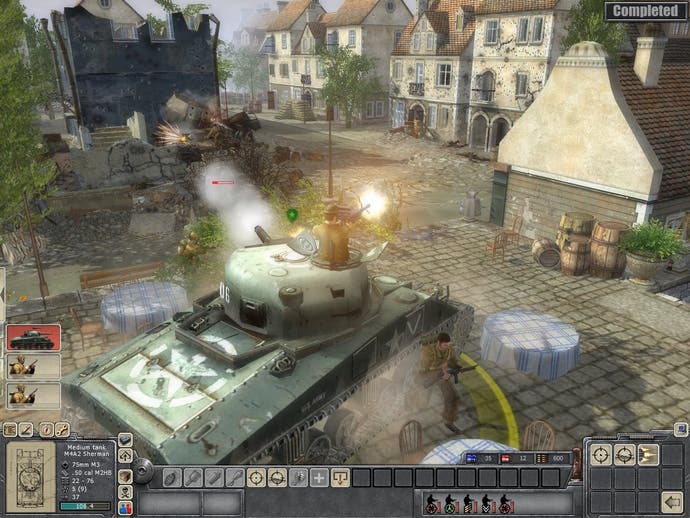Men of War
Company of Heroes has company.
Well, almost. While infiltrating a Tunisian town crawling with Axis troops or dodging parachute flares and German patrols on the heavily-fortified Seelow Heights brings back happy memories of Tiny and Fins, Best Way's covert capers just don't have the depth or credibility of Pyro's. New, toggleable vision cones mean you can judge darting runs to perfection, and a corpse-carrying capability lets you clean up after silent kills, but that's as far as the cloak-and-dagger facilities go. There are no distraction or co-ordination mechanisms, no disguises, and most noticeably, no clever alarm AI. Cause a rumpus, and goons will come running, but their searches are perfunctory, their memories short.
One quality Men of War does share with the Commandos series is exquisite, highly detailed maps. The European and North African environments that dominate the campaigns feel, for the most part, like real locales rather than scenario-driven shorthand. They're packed with bespoke structures and pleasing detritus. Because everything from a rusty harrow to an abandoned field kitchen can be utilised as cover, all this picturesque clutter really matters.
And, blimey, some of the maps are huge. The German campaign begins with a historically-based fallschirmjager drop on Crete. A gruelling succession of hamlets and hillocks must be contested before, finally, the last area of the battlefield - the crucial Maleme airstrip - is revealed. By the time you storm the control tower and vanquish the Matilda tanks lurking in the furthest hangars, you feel like you've conquered a continent.
One of the beauties of colossal scenarios like 'Mercury' is that they're ridiculously ripe for replay. The first time you fight, you might choose to go up the left flank, relying on mortars and slow, patient sniping to clear a path. The second time, you might go right, blasting your way to victory with grenades and Schmeissers. The third time, maybe you take a captured anti-aircraft half-track straight up the middle, or run riot with a pair of commandeered MG Jeeps.
In the unlikely event you ever tire of solo slaughter, there's always the option to explore the superb Gamespy-supported multiplayer. All twenty-five of the campaign episodes can be enjoyed co-operatively. Considering how stiff the opposition often is, this is a wise concession. Having a friendly force advancing beside you, ready to lay down suppressive fire, or supply a toolkit or morphine ampoule at a critical moment, turns a great game into a fantastic one.

For more competitive multiplayer there are various deathmatch, capture the flag, and attack/defend modes ranging from the cosy (2 vs 2) to the epic (8 vs 8), plus a Goldrush-style escort game where each side battles to bring a precious cargo back to their base. Playing these is the only way you'll get to experience Men of War's limited take on base-building (erecting sandbag walls) or see the fifth of its well-equipped factions (the Japanese) in action.
This might be the most gripping tactics title I've played in getting on for a decade - the Close Combat series still take some beating - but its thick, rakishly sloped armour is not impervious to criticism. In addition to those faintly disappointing stealth episodes, the developers have done themselves no favours with their optimistic difficulty settings ('easy' should be relabelled 'quite tricky actually'), skimpy tutorial, and mediocre writing and voice acting. While the in-engine cut-scenes are entertaining enough, and the plot is fundamentally sound, briefings and narration feel more Thin Blue Line than Thin Red Line.
But then, Men of War doesn't need a slick Hollywood narrative to succeed. It does its stunning storytelling on the hoof and on the battlefield. It writes its dramas in blood, and fire, and bullets. Buy this game and you're buying a thousand spontaneous war stories. Buy it and you are buying that rare thing - a military RTS that doesn't have to bow and scrape in the presence of the magnificent Company of Heroes.